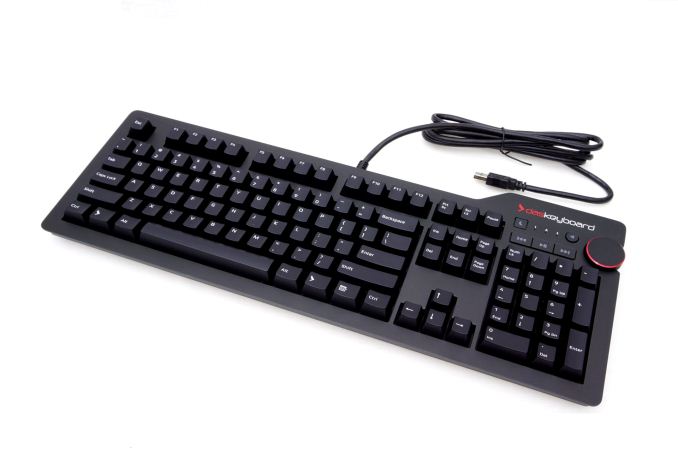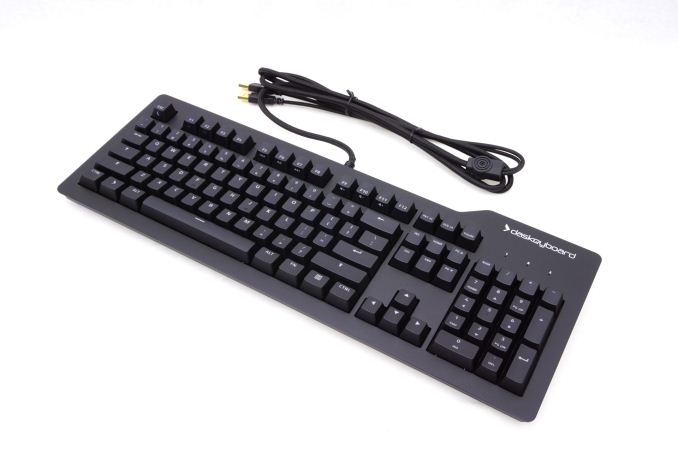The Das Keyboard 'Prime 13' & '4 Professional' Mechanical Keyboard Review
by E. Fylladitakis on January 10, 2017 8:00 AM ESTConclusion
In this review we had a look at the new Das Keyboard Prime 13 and the popular Das Keyboard 4 Professional. The keyboards do share a similar appearance and the same quality mechanical switches from Cherry but, to our eyes, each keyboard is targeted towards an entirely different group of users.
The Das Keyboard 4 Professional is a mechanical keyboard that has been clearly designed with professional users in mind, with the company forthrightly marketing it as such a product. Conscious professionals need devices that are aesthetically elegant, productive and durable. We cannot claim that the Das Keyboard 4 Professional will increase your productivity any more than any other similar mechanical keyboard, yet we can state with certainty that it is a very high quality product that will easily last a decade of heavy daily use. The USB 3.0 hub is a useful thing to have, especially in an office environment where devices like flash drives are frequently used.
With its intended primary target group being conscious professionals and office workers, we feel that the Das Keyboard 4 Professional is a perfect match for a modern workspace. We can only negatively comment the lack of programmability, which will be an issue for certain categories of professionals. For example, programmers tend to reprogram certain keys to insert ready, frequently repeating code and CAD users to perform certain repetitive functions. It is an expensive product, yet not overly so for a top tier professional keyboard. Its primary competition is primarily coming from the Cherry MX Board 6.0, a slightly more expensive professional keyboard with backlighting, but also lacks the sound volume knob and the USB 3.0 hub.
A quick glance can easily lead someone to the conclusion that the Das Keyboard Prime 13 is practically the same keyboard as the Das Keyboard 4 Professional, but that would not be a very accurate statement. The company still markets the Prime 13 as a keyboard to "get the job done", hinting that professionals still are a focus group of this keyboard. However, the marketing phrasing and the changes from the Das Keyboard 4 Professional hint that the company is trying to target a wider audience. This becomes clear when one notices that the company is trading features that can be of use in a strictly professional environment (the USB 3.0 hub, the extra buttons, and even the ruler) with LED backlighting, a feature that is generally found appealing by gamers and home users. The inclusion of the keycap puller and the use of Cherry cross-type stabilizers also hints that the designer intended for the user to be capable of removing/replacing the keycaps, something clearly not taken into account during the design of the Das Keyboard 4 Professional.
In our opinion, the Das Keyboard Prime 13 is having a bit of an identity crisis. Due to the proximity of its price to the Das Keyboard 4 Professional, a professional user would almost certainly buy the 4 Professional instead. For home users and gamers, the Prime 13 may be a keyboard of outstanding quality, yet there are several competitive products based on Cherry MX switches, with backlighting, that sell for less than $150. Many of them are offering features useful for gamers, such as extra macro keys and full-layout programmability, which the Prime 13 is lacking. The Das Keyboard Prime 13 could become an excellent choice for users that want a very high quality keyboard for their all-around home PCs, especially for professionals that work from home, but lower retail prices are needed to make it a truly competitive product.












58 Comments
View All Comments
WorldWithoutMadness - Tuesday, January 10, 2017 - link
Please do a review about Topre realforce RGB!Krause - Tuesday, January 10, 2017 - link
I don't think any of these tech sites review the actual high end mechanical keyboards, i've never seen a site like this with a keyboard review/mechanical best of list that actually contained a single keyboard that should be there.Flunk - Tuesday, January 10, 2017 - link
They review what the manufacturers send them.tachi1247 - Tuesday, January 10, 2017 - link
They also can make requests to mfr's for reviews. While smaller sites and individuals will be sent things by manufacturers for reviews to help spread the word about the new product, a site like Anandtech has the industry clout to approach a manufacturer and request a sample for an upcoming article.Holliday75 - Saturday, January 14, 2017 - link
I wonder if Anandtech could....persuade people to turn over samples for testing. Say publish an ever expanding db of devices they requested and either a link to the article or a refusal by the manufacturer to send one. Naturally people will ask why, what are they hiding and could look bad on them.JCB994 - Tuesday, January 10, 2017 - link
What are the high end mechanical keyboards?JoeyJoJo123 - Tuesday, January 10, 2017 - link
The same ones as the low end mechanical keyboards. The difference between Kailh or authentic Cherry MX isn't as noticeable as the difference between $5 rubber dome office keyboard and an average $70 mechanical keyboard.Any further differentiation is pretty absurd and ultimately comes down to brand preference or possibly elitism. The entire point is that mechanical key switches have a MTBF of millions of keystrokes, which is several orders more reliable than rubber dome key switches.
Fallen Kell - Tuesday, January 10, 2017 - link
The difference between a good mechanical keyboard and a crappy one is the same reasoning why rubber dome key switches were invented in the first place, cost cutting. The difference of type of plastic used in a part can be the difference of lasting for 10's of years without reacting to sunlight and oils/grease/dirt from people's hands/fingers or just making it long enough to exceed the keyboard's product warranty. It is the difference between using double-shot keycaps vs "painted and laser etched". A double-shot keycap will never wear out the character on the key from normal use, but laser etched keycaps will wear at some point as the paint does not last forever (unlike physical plastic which will last hundreds of years). The support braces used are another huge area of cost cutting which ultimately affects how well the keyboard survives. And then there is the matter of the switches being properly secured and supported into the PCB (a quick way to cut costs is to skimp on that physical connection, leading to solder points cracking over use as they take the load of the fingers hitting the key).Jetpil0t01 - Sunday, January 15, 2017 - link
I have a Razer Blackwidow Tournament Stealth 2014 and a Das Keyboard 4C Pro TKL and the difference is entirely down to build quality. I actually prefer the typing experience on the Razer, but you can clearly tell the quality of the build of the Das is much better. That being said, I have never had any keyboard in the last 20 years break due to poor build quality of the case, keys, cable or anything else, so its arguable the build quality doesn't add up to much in real terms. I have had the WASD keys on an expensive membrane board get mushy after 5 years of use, but that's still 5 years of use for under $100 which again to me seems trivial as far as the expense of replacing it.I can understand exactly why you would buy the Das Pro model featured here, the USB 3.0 and media controls as well as the clean but sharp aesthetic work perfectly in the office. If you are using it for productivity, the price also becomes trivial, so being higher quality makes sense. Plus there is little to no chance people will be dropping a Corsair RGB into the office without looking like a complete tool, so this seems to hit the target market perfectly.
In the home however, the prime board starts to make little to no sense, outside of brand appeal. If it still had the USB and/or media controls the price might work, but where it is now, there are simply more feature rich products for less money, so it's going to have a tough time selling on build quality alone.
All they needed to do here IMO was take the previous model, drop PBT caps on it, upgrade the hub to USB 3 and keep that in both models and you would have a compelling product. As it is, I would have a hard time recommending this over a Deck or Ducky board for professional or home use and I have had two Das boards previously.
Krause - Tuesday, January 10, 2017 - link
The difference comes down to build quality and keycap material. Any POS that uses clear ABS (garbage plastic) keycaps that are then painted a dark color except for the legend to create cheap backlighting instead of doing true double shots should automatically be given 1 star out of pure principle.On a positive note though, painting (or "coating" in a rubberized spray paint if they try to spin it as a feature) completely negates the importance of using better plastics as the cap material in the first place so it really didn't matter if they used cheap ABS or PBT.